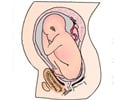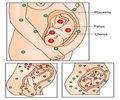Even low doses of endocrine disruptors such as estrogen can alter gene expression to the extent that it also affects the next generation. This finding adds to the debate on endocrine disrupting chemicals affecting human health.

‘In a pig study it was found that even low doses of endocrine disruptors such as estrogen can alter gene expression when given during early pregnancy. The findings could potentially apply to humans too, observe the team of researchers.’





In an experiment with pigs, researchers from ETH Zurich and the Technical University of Munich have demonstrated for the first time that the administration of even extremely low doses of an endocrine disruptor - in this case, an endogenous estrogen - leads to epigenetic changes in a pregnant sow's (female pig's) DNA. Moreover, these changes were also observed in the sows' embryos, and similar changes were even evident after the offspring had reached adulthood. The study was recently published in the journal Scientific Reports.A time window of increased sensitivity
"EDCs, especially estrogens, are highly effective even at very low doses," says Susanne Ulbrich, Full Professor of Animal Physiology at ETH Zurich. Whether endo- or exogenous chemicals have an effect, and how strong that effect is, also depends on the point in time during which the exposure occurs. "For example," Ulbrich explains, "the body is particularly susceptible to external disruptive hormonal influences during the embryonic phase of early pregnancy."
Ulbrich and her colleagues examined exactly such a time window in their study with pigs: to simulate the intake of EDCs via drinking water or food, they exposed pregnant sows to varying doses of estradiol-17£], a natural estrogen, via their daily feed either over the course of the whole gestation period or only during the first ten days after fertilization.
The lowest dose corresponded to the acceptable daily intake for humans (0.05 micrograms per kilogram body weight). In the same experiment, the scientists administered two other dosages: one close to the "no observed effect" level (10 micrograms per kilogram body weight daily) as well as a higher dosage (1,000 micrograms per kilogram daily) - the latter to simulate the accidental taking of the contraceptive pill in early pregnancy. The experiment included a control group of pigs that received no estradiol.
Advertisement
Changes in gene expression
Advertisement
In addition, the researchers observed epigenetic changes in a few selected genes in the sows' liver. Similar changes to these genes also appeared in the embryos and in the adult offspring: even in the one-year-old female offspring, the researchers were able to determine that the epigenetic pattern of these genes had been altered.
Epigenetic changes occur for example through the addition or removal of small chemical groups, such as methyl groups, at certain points in the DNA. This can alter the expression of the affected gene, and in turn change the cell's function.
Lasting changes
"We didn't find any serious impact on the health of the adult offspring; we saw only slight changes, such as in bone density and the ratio of fat to muscle mass," Ulbrich explains. However, it remains unclear what long-term effects the epigenetic changes might have, and whether the interaction of the many EDCs humans are exposed to on a daily basis render the situation more acute.
"There is an urgent need to observe this phenomenon over several generations in a long-term study," says the ETH professor. "Epigenetic changes can emerge within just one generation, but in certain circumstances they will continue to be transmitted to succeeding generations. We can already clearly demonstrate that hormones, even after a brief exposure period and in very small amounts, can have a measurable effect," she concludes.
Based on these results, Ulbrich, an expert in reproductive physiology, is calling for a re-assessment of the acceptable daily intake value and the "no observed effect level" dosage. She notes that pigs' hormonal changes during pregnancy closely resemble those in humans, so the results of the study are highly applicable to humans; they may even be more appropriate than findings from a study of, say, mice.
"At the moment, recommended threshold levels are probably too high," Ulbrich says. No matter how tiny the estrogen dosage, the epigenetic changes she and her team observed clearly evidenced that the test subjects had been exposed to an EDC. She continues: "How exactly that resulted in the changes and what impact these changes will have in the long run requires closer study. The sensitivity of embryos in the early days of pregnancy should under no circumstances be underestimated."
Source-Eurekalert















